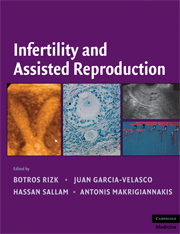Book contents
- Frontmatter
- Contents
- Contributors
- Foreword
- Preface
- Introduction
- PART I PHYSIOLOGY OF REPRODUCTION
- PART II INFERTILITY EVALUATION AND TREATMENT
- PART III ASSISTED REPRODUCTION
- PART IV ETHICAL DILEMMAS IN FERTILITY AND ASSISTED REPRODUCTION
- 69 Stem Cell Research
- 70 Fertility Preservation in Female and Male Cancer Patients
- 71 Ethical Dilemmas in ART: Current Issues
- 72 Infertility Treatment in Perimenopausal Women: Ethical Considerations
- 73 Religious Perspectives of Ethical Issues in Inferility and ART
- 74 The Future of Assisted Reproduction
- Index
- Plate section
- References
73 - Religious Perspectives of Ethical Issues in Inferility and ART
from PART IV - ETHICAL DILEMMAS IN FERTILITY AND ASSISTED REPRODUCTION
Published online by Cambridge University Press: 04 August 2010
- Frontmatter
- Contents
- Contributors
- Foreword
- Preface
- Introduction
- PART I PHYSIOLOGY OF REPRODUCTION
- PART II INFERTILITY EVALUATION AND TREATMENT
- PART III ASSISTED REPRODUCTION
- PART IV ETHICAL DILEMMAS IN FERTILITY AND ASSISTED REPRODUCTION
- 69 Stem Cell Research
- 70 Fertility Preservation in Female and Male Cancer Patients
- 71 Ethical Dilemmas in ART: Current Issues
- 72 Infertility Treatment in Perimenopausal Women: Ethical Considerations
- 73 Religious Perspectives of Ethical Issues in Inferility and ART
- 74 The Future of Assisted Reproduction
- Index
- Plate section
- References
Summary
This chapter was based upon the presentations of a symposium at the 59th American Society for Reproductive Medicine (ASRM) annual meeting in San Antonio October 2003. This was the ASRM/MEFS cultural exchange session and I was asked to put together presentations that represented the views of the main religions. The Jewish, Christian, and Islamic views were presented by Sherman Silber, Botros R. M. B. Rizk, Pier G. Crosignianni, and Gamal I Serour. This symposium was very stimulating and generated interesting discussions and published by the Middle East Fertility Society Journal in 2005, Volume (10), third issue. This chapter is produced with the permission of the journal with minor updating of my section. This led to another session at the ASRM 60th Annual Meeting in 2004 where presentations covered some more focused topics as stem cell and cord blood. Three presentations were given by Joe Leigh Simpson, Robert Casper, and Botros R. M. B. Rizk.
Religious Perspectives of Ethical Issues in ART. Middle East Fertility Society Journal 2005;10 (3): 185–204.
INFERTILITY, IVF AND JUDAISM
Different Branches of Judaism
For most Jews, Judaism is not well defined. There are three main branches to Judaism: “Orthodox,” “Conservative,” and “Reformed.” Only about 10% of Jews worldwide are Orthodox, and only Orthodox Judaism is quite well defined. Approximately 85 percent of Jews worldwide are “Reformed,” and these Jews are, for the most part, secular. About 5 percent of Jews are “Conservative,” which is a sort of a hybrid between Orthodox and Reformed Judaism.
Keywords
- Type
- Chapter
- Information
- Infertility and Assisted Reproduction , pp. 728 - 746Publisher: Cambridge University PressPrint publication year: 2008



